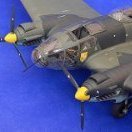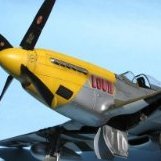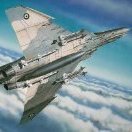Search the Community
Showing results for tags '1/72'.
-
Hello all, Here is my attempt at the 1/72 Das Werk SM U9. I have to say I really enjoyed this kit. It goes together very easily and is engineered well. Most of the effort on this was spent on painting and weathering. I used Model Master and AK paints. Most all of the weathering was done with water colors. I also added RCsubs photo etch set. I would like to thank Tony” The Deck Guy” Quartaro for the base. Thanks for looking. Rod
-
Evening all, I put the finishing touches to this earlier this week: the new-tool 1/72nd Airfix B-17G converted to a US Navy PB-1W airborne early warning aircraft. I used the old 299Models conversion which gives you the big radome in short-run injection plastic, as well as blanking plates for the top, chin and ball turrets. The conversion was actually designed and produced long before the excellent new-tool Airfix Fort was released and is meant for the Hasegawa kit. However, with some gentle persuasion, it fits the Airfix kit well. The PB-1Ws were late build B-17Gs taken from desert storage post WW2 by the US Navy and stripped of their bombing equipment. Some retained their tail guns but these were soon removed, and quite crude blanking plates were added to the openings for the top, chin and ball turrets. The main distinguishing feature of the PB-1W was the large AN/APS-20 search radar added to the bomb bay and huge dome slung beneath. In all 32 B-17Gs were converted to PB-1Ws and they remained in service until the mid-1950s when they were superseded by Constellations. The model was airbrushed with Xtracolor’s Sea Blue gloss and decals came from the spares box. I toned it down with a coat of Humbrol Satin (the real things were actually high gloss) and added some oil and exhaust with pastels. All in all a very simple conversion (if you can find one!) and it’s nice to add this unusual Fortress to my collection. All the best, Tom
-
Issues with posting photos... Back in a moment...
- 12 replies
-
- raaf 76 sqdn
- p-40n
-
(and 3 more)
Tagged with:
-
Afternoon all, Here's the latest model to take off from my bench - the new-tool Airfix 1/72nd Avro Vulcan BMk2. After grafting on some very long-term projects of late I decided I needed something relatively straightforward for a system reset and mojo reboot and this proved to be just the project. I found it an absolute delight to build - actual construction only took four evenings and the whole model was completed in just under two weeks. In fact, it's the first model I can remember in absolutely ages that I didn't put down for a few weeks and return to it later as I'd lost interest - I just wanted to keep going! As with most of Airfix new-tool kits, tolerances are very tight indeed and therefore I gave each surface to be glued a quick swipe with a sanding pad and this meant an almost perfect fit for all components. I was really impressed with how the intakes went together, and with a quick swipe of Milliput White they look seamless with the minimum of effort. I wanted to do a later version than is currently supplied in the box so bought an Xtradecal sheet to make a 101 Squadron machine based at RAF Waddington in the mid 1970s. Two type of jet pipes are provided in the kit, and I had no idea which were fitted to this aircraft so went with the same as the one currently preserved at Duxford as they seemed of the same vintage. The kit's bomb bay is beautifully rendered and with some careful painting comes up beautifully out of the box. If you build this kit, don't waste your time detailing the interior of the cockpit as next to nothing can be seen - I just did the absolute basics. Xtracolor enamels were used throughout and I gave it a satin varnish as these machines seemed very well maintained in service and other than a few streaks and stains here and there, I kept her reasonably clean as period photos suggest. I recommend this kit to anyone looking for a large and impressive model in their display cabinet but not requiring a huge amount of effort - it's a pleasure! Tom
-
I went to Duxford recently to see the now-finished "Evolution of the Spitfire" exhibition, stroll up to the American hangar, and generally soak up the atmosphere. I finished in the gift shop, and as one does I left with some plastic, an Airfix Spitfire Ia in 1/72. It was a bit of a challenge as I don't think I've built a 1/72 Spitfire since about 1995, but I thought I'd do it completely out of the box with no additions and the kit marking for an aircraft of 92 Sqn in May 1940, just before the Battle of Britain. And 10 hours or so of modelling time spread over three weeks later, here it is, and it made a nice little "palate-cleanser" before I tackle a couple of large-scale Spits and maybe even get back to the Mustang. And finally, I had forgotten just how tiny a 1/72 Spit is, but here it is compared to a Revell IIa fuselage half. Thanks for looking.
-
This is the Hasegawa kit in 1/72. It's not a bad model, although I did have some issues fitting the engine nacelles that required a bit of filling and sanding, otherwise things went together well. Chinese markings come from the spares box with the fin flash being masked and painted. Surprisingly, the colour picture which my build is based on shows the aircraft in a reasonable condition, thus I chose not to highlight all the panel lines, just those around the engines as they appeared a bit grimey. I am lacking some white numbers on the tail, I couldn't find small enough decals in the spares.
-
Our club sponsors a 'Build the Same Kit' contest every year, which includes aircraft and armor options so thought to try something different I'd take on a small project : the Trumpeter Bradley M2A2 but dressed in WWII Camo scheme. The kit was very cheap, so why not? The obligatory box art shot: Not a lot of parts to the kit, but a fair amount of interior detail considering the scale and most of it will be covered up: I have interior shots SOMEWHERE but no clue where they went. There are a LOT of seats inside one of these things, but unless you put the read door down and open some hatches, not much to see. I kept the build simple. All closed up - but take my word for it, the full interior is there! So after laying own the German dark yellow base, I started on the Camo scheme. The top two are the schemes I tried to emulate on the Bradley. Lots of details to be picked out after the Vallejo Olive Green is added, antennas to add, muzzle soot, etc. There are a couple of spiders I need to clean up but this is one of my first attempts with the H&S .2 tip (and this is 1/72 scale!) so overall pretty happy with the results. Next a clear gloss to aid in washes. Probably should have painted some of the detail such as the tow cable and jack and even the shovel before applying the camo. Oh well! Chris
-
A little Luftwaffe '46 for today, the very nice Revell 1/72 Focke Wulf Flitzer. Believe it or not this aircraft actually made it to the wooden mock up stage, but never progressed further. I've equipped mine with a pair of 21cm mortar tubes from a 262 and two X-4 wire guided air to air missiles as a bomber destroyer. The little tractor is from Academy and the base was made from scrap plastic and the base of an old trophy.
-
So having all these builds (B-25, F-4E, PR XI Spitfire) I thought I'd throw in something different. What is it? Zoids are a Japanese Sci-fi series from the '80s and' 90s. Basically they're armed cyborg dinosaurs that have lots of guns, rockets and, a shopping basket... Gotta have a shopping basket for all your extra ammo. Similar to most Bandai kits, it's a press fit and glue isn't a must but definitely handy in certain places. The biggest hurdle is the paint scheme since pretty much every color is a custom mix of Gunze paints. So I stated with the main colors which are various shades of blue. Not being that skilled at brushwork, I decided to first paint and then mask off the teeth. Then I sprayed the black.
- 8 replies
-
- Zoids
- Kotobukiya
-
(and 1 more)
Tagged with:
-
This is a nice little kit. The Belgium markings offer a nice change of pace to RAF markings and the decals settle down nicely under some Mr Mark decal fluid. I had read of some issues fitting the fuselage to the wing, but some clamping solved any problem there and the fit is actually quite good. I've been buying quite a few of these new Airfix kits and I'm quite pleased with them.
-
I can't seem to make any headway with my two 1/32 Sopwith Camels - the rigging just has me in knots (Ha ha, that was a LITTLE funny, right? ). But I've found some enjoyment in some of the 1/72nd kits and the Eduard kits are just a joy to build. Fit and detail are amazing for kits in this scale, instructions are very clear - and they don't take up a lot of space. Ok, so why twins? I purchased a Profi-Pack kit of the Spitfire Mk IXc, and knowing I have many different decals to play with, purchased an Mk IXc OVERTREES set to go with it. My first Overtrees - which is simply a sprue-only kit - no decals, masks, PE or instructions (which for Eduard can be downloaded from the site - but I used the Profi-Pack instructions anyway. Here is the kit box: Here is the OVERTREES label. They also make available the PE frets if you want too... Since I can build two kits at the same time I decided to try some different things with the OVERTREES build - namely some masking (those D-Day Strips) and the camo masks work and a non-PE IP. Turns out, you really can't see much of a Spitfire IP anyway. Unfortunately, I should have bought a second set of canopy masks - masking the tiny Spit front windscreen takes a steadier hand than mine so I'll either try and reuse the masks from the Profi-Pack build or may give tape another go. Here are the two birds I'm building; (DU*N) as the Profi-Pack and the OVERTREES build is (WX*D). Apologies that I'm jumping into this build at probably more like the 75% (where did I put those build pics?? The masking for the camo alone took me a day!) but here is where I'm at so far. Still need to finish the landing gear and start the weathering, as well as adding the antennas, fuel caps, pitot tubes, etc. WX*D is on the left, DU*N is on the right. The camo is Vallejo Model Air and the Sky fuselage bands are painted as are the yellow leading edge stripe. On DU*N, the red 'tape' covers are painted on, while on WX*D they are the kit decals. Honestly, for as easy as it was to mask, so much easier to paint than try and align the 4 decals. For looks? I think after sealing with a clear coat then a matte or flat coat it will be a wash. But I like painting them better. Ideally, I was going to use masks for the national insignia on WX*D, but in the end, I kind of just wanted to get on with it. And the fact that the Eduard decals react beautifully to Micro Set. I 'paint' on some Micro Set where I want the decal, put the decal down and cover again with some Micro Set. I'll revisit in a couple of minutes, using a brush to smooth out any wrinkles but very quickly all the decals snuggled down into the panel lines. NOTE: What I've found is you don't have a lot of time to move and adjust the decal with this method. The solution gets to work very quickly breaking down the decal and if you don't move fast enough (15-25 seconds max) it can turn to mush. That reminds me. The 'door's on both aircraft will be open, the ones there are just masks for the fuselage painting. I also used more of the stenciling on DU*N although again, at this scale, unless you know where to look they are actually very hard to see. Next up is another clear coat to seal in the rest of the decals and then start on some weathering - esp on the underside. Not going to go crazy, but hope to show some of the oil streaks common to the type. DU*N also has a lot of the PE grills and screens so hope to show those off a bit better. I'll work on some better photography for the next batch, hopefully! Thanks for looking and of course, comments are welcome. Chris
-
Our club does an annual 'Group Build' called Build the Same Kit. This year its the Hellcat and mine is the Eduard 1/72 kit. I chose Lt. Stambook, VF-27 from the USS Princeton as my subject (kit decal options) since it had that nice mouth on it (can't really say its a sharks mouth). Already in progress using mostly Vallejo and Model Master paints. This is the Profipack kit, so it has the PE parts for the cockpit (color photoetch). For the first time I was able to get all of the various switches in place and the PE seatbelts. I've seen a few different light blues on these aircraft, but have a feeling the blue I chose is just a LITTLE too bright. Interesting too is that the kill markings are on the right side of the aircraft. Had not seen that before. VF 6 and VF 33 seem to have done this. Working on the washes now, using a light gray around the gun ammo doors (as I've seen in reference photos) and black on the folding wing and flaps. Best as I can tell, the rest of the panels for the most part were not outlined so just leaving them alone. Will hit with a matte finish at the end. Thanks, Chris
-
Hi All, In between (still) continual pattern making, I have decided to have a go at making a smaller model and attempt to try and have it completed for the IPMS Newark and Lincoln Expo competition in October (something I last did 16 years ago!). I am not confident that I will achieve my target as I have got a lot of other things coming up to stop me, but I will give it a try. I have selected the Heller 1/72 AMD Mirage IV A kit as my first attempt at 'rehabilitation' back into normal modelling again (whatever 'normal' is measured as!). The first thing to tackle is the cockpit. As can be seen, it is pretty basic at best (and inaccurate as well). This is the re-worked and detailed rear cockpit weapons operator's instrument panel (I am amazed that I can still even see any details in this scale let alone make them!). Kit landing lights installed and sanded. If I get the kit completed in time, I will foil it, as the last time that I did this (2004), it seemed to come out pretty well. And hopefully, it will turn out something a little like this! If I do get the Mirage completed in time, and there is any time left, I will also try and complete one (or both) of these in a similar foiled NMF finish - I have elected to make the Sk 37 Viggen and S 29C Tunnan from these kits (the old Matchbox J 29F Tunnan has been assembled purely as a test airframe for foiling technique practice). Derek
- 19 replies
-
I started modelling in the late 60's, with Airfix, Frog and Heller "Musée" kits, all in 1/72. Then came Matchbox, with their fast-paced release of 1/72 kits, molded in garish colors, and still remembered today for their famous "trenches" recessed panel lines. Their range was not only wide, it was full of original subjects, and it was available through a wide array of stores. The tobacconist near where my parents lived soon received regular visits from me, to buy the last Matchbox kit. With my modelling buddies of the Geneva and Savoie area, we have a yearly "challenge" for fun, to be completed for the last meeting of the year, before Christmas. This time, one of us had the opportunity to buy from a retiring gentleman, at a good price, a wide collection of Matchbox kits, some of them in their original boxes of the early 70s. Thus was born the "Matchbox challenge" : to build an OOB 1/72 Matchbox kit of our choice, using what we know today, but without major modifications. I could not resist the nostalgia bout, and the idea of building an OOB kit without any self-imposed pressure, seemed a good way to boost the modelling mojo. I chose three kits : the Hawker Fury (PK1, the first ever Matchbox kit), the Boeing P-12E (PK3, their third kit) and finally the strange looking Vickers Wellesley. The Fury and P-2E were in their original 1972 box. For technical reasons, as we changed the restaurant where our monthly gatherings take place, we decided not to bring our kits of the Matchbox challenge for the Christmas diner, so this will be at the end of this month, and this gave me the extra hours to finish the pesky rigging. I focused on building the Boeing P-12E (you can't get enough yellow wings !). It was actually (as the Fury btw) a nice little kit, with good fitting, fine details and fairly thin trailing edges. The panel lines were fine raised ones. The kit still holds its own some 43 years afetr its first release compared to some modern releases. I just detailed the cockpit, by adding a dashboard, a joystick, a facsimile of the gun-breeches and the tubular structure holding the IP and guns, and finally refining the seat. all the other parts as OOB. I rigged it (aaaargh !) using Uschi's "standard" elastic rigging line. This was the most difficult part of the build : these wires are really small ! I chose one of the in-box schemes, a P-12E of the 27th Pursuit squadron, 1st Pursuit Group, in 1935. One pic I had showed it had a tail skid rather than the kit-supplied tail-wheel, so this one was done with three small pieces of 0,5 mm plastic rod. The decals are from the box. They were a bit old, and by precaution, I added a layer of Microscale decal liquid film on top to keep them together. This did not prevent the underwing "U.S. Army" logo to disintegrate somewhat, but I managed to bring the pieces together. Not sure about the density of the white in the stars and rudder-bars, I masked the white primer to have white disks under the forthcoming decals. It was effective. Et voilà ! A good fun project, that did me a lot of good, first because of the nostalgic content and second by the benefit of stress-free OOB build. Hope you like it. Hubert [/url]
- 7 replies
-
- Metchbox
- Boeing P-12E
-
(and 1 more)
Tagged with:
-
Before Lewis Lynch served as a Navy Medic in San Francisco, caring for wounded arriving from the Pacific Theater, he worked at the Martin Aircraft Plant in Omaha, Nebraska... He grew up in the Sand Hills of Nebraska and to survive the deprivations of the Great Depression, he and several members of his family migrated to Omaha to scratch out a living in the Martin factory... It was at the Martin facility in Omaha that the B26C Marauder was assembled and later the B29 Superfortress... Lewis was involved in B26C builds... In March 2015, Lewis Lynch will turn 93, and as celebration of his birthday, my 15 year old son Parker and I will assemble a Hasegawa 1/72 B26C and hang it from his ceiling in his home. Lewis Lynch is my son's grandfather... Just below is an archival image of a B25C exiting the assembly plant in Omaha: This will be a straight OOB and clean (I hope) build. Since Lewis only saw brand new versions of the B26C, we do not plan on weathering the plane at all. Here's the Hasegawa kit box and cover art: Not quite as overwhelming as a 1/32 scale Tamiya Superkit, but enough to keep us busy for a while. I've not built a 1/72 scale aircraft since a completely hand-painted Japanese Zero in 1961 and am far more used to working with 1/32 scale, so this will be a different experience. Here's a shot of the kit's contents: This afternoon Parker and I assembled the cockpit and bomb bay... I was actually astonished how quickly this portion of the build went, which is an attribute of the 1/72 scale... Since each of these subassemblies are a single color (mostly Zinc Chromate), we put them together and then I'll airbrush the paint on... here are the initial assemblies: Here is my build partner: And finally, here is the aforementioned Lewis Lynch taken back during the days of WWII: Here is Lewis in a more recent photograph:
- 17 replies
-
- Medium Bomber
- WWII
-
(and 3 more)
Tagged with:
-
Not a bad little kit, although the decals were pretty thick and detail is sparse. I masked and painted the fuselage red and white along with the anti glare panel and the wing leading edge. I really should have painted on the roundels too. This aircraft was armed with two 40mm HO-301 cannon designed to knock down B-29's, but in reality, the weapon was just as lethal to the pilot as the B-29 due to the low muzzle velocity. Pilots had to get dangerously close to open fire with any accuracy.










